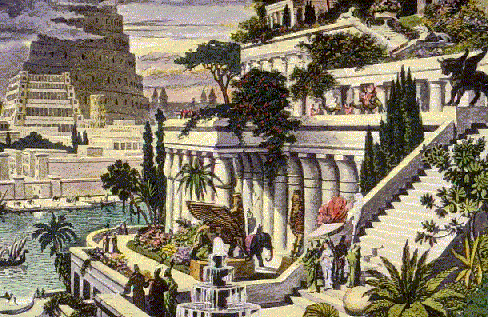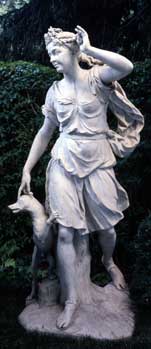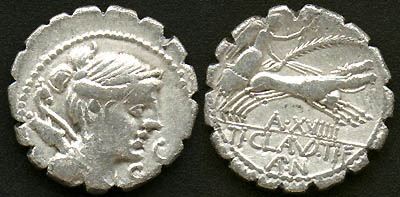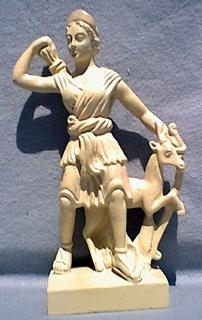

"The White Moon Gallery Presents"
Diana of Ephesus
by Qu'Aryn Teal Moon
Mythology:
|
|
Diana was the daughter of Jupiter, the Chief God and the twin sister of Apollo. Her mother, Latona, was one of Jupiter's paramours. When Diana was born her mother bore her painlessly, and then Diana helped her mother deliver Apollo, thus making Diana the Patroness of Childbirth.
|
 As a child Jupiter asked Diana what she like to have as gifts. She replied that she wanted eternal virginity (in the sense of always being true to her own nature), as many names as Apollo, a bow and arrow like Apollo's, the office of bringing light (providing guidance to others), a saffron tunic with a red hem, and nine nymphs as her maidens.
As a child Jupiter asked Diana what she like to have as gifts. She replied that she wanted eternal virginity (in the sense of always being true to her own nature), as many names as Apollo, a bow and arrow like Apollo's, the office of bringing light (providing guidance to others), a saffron tunic with a red hem, and nine nymphs as her maidens.
"Diana Leaving the Bath", Frances Boucher (1703 - 1770)
On one occasion as Diana was bathing (ritual bath symbol) with her attendants, when Acteaon the Hunter chanced upon them. As he spied upon her, Diana changed him into a stag, and his hounds promptly killed him (defeating the arrogance of human desire).
Diana was believed to hunt in the moonlight with her hounds. She can see clearly in the dark, guided by the moon (her own intuition).
|
The Temple at Ephesus:
|
 Artist rendition of the Temple of Diana at Ephesus.
Artist rendition of the Temple of Diana at Ephesus.
|
|
One of the Seven Wonders of the Ancient World was The Temple of Diana in Ephesus, Turkey. By most accounts the worship of this Great Goddess was the impetus for one of the largest and grandest temples in the Ancient World. Her followers, admirers and detractors wrote about her from the stories of Troy to the Christian Bible, in which she is noted as the Great Goddess.
"Acts|19:27 So that not only this our craft is in danger to be set
at nought; but also that the temple of the great goddess Diana should
be despised, and her magnificence should be destroyed, whom all Asia
and the world worshippeth.
Acts|19:28 And when they heard these sayings, they were full of
wrath, and cried out, saying, Great is Diana of the Ephesians."
(from the King James version of the Bible)
|
These verses show that the Ephesians devotion to Diana was so great that the Christians in Rome considered her their greatest rival. The multi-breasted statue of Diana at the Temple displayed her capability to nourish all creatures and provide for them. She was known by many names including Queen of Heaven; the Great Goddess; Lunar Virgin; Mother of Animals; Lady of Wild Creatures; the Huntress; Patroness of Childbirth, Nursing and Healing; and Queen of the Witches.
|
Worshipping Diana Today:
|
|
In his book "Ways of the Strega", Raven Grimassi draws a calendar which shows that the worship of Diana has never been discontinued in Italy. Throughout the centuries, women have continued to worship Diana as their patroness. Charles Leland discovered this and thus wrote his groundbreaking work "Aradia, Queen of the Witches". Aradia is believed to be the daughter of Diana.
In "The Woman's Encyclopedia of Myths and Mysteries" Barbara Walker draws parallels between the worship of Diana at Ephesus and the subsequent renaming of the Christian Madonna. Worshippers at Ephesus adored Diana so much that the only way the Christians could rid the people of their Goddess was by assimilating her into their new religion. Thus Ephesus became a place of Mary, Mother of God. The church even invented stories of Mary living at Ephesus and being entombed there.
|

Statue of Diana the Huntress used as garden ornament in Versailles, France.
Sacred to Her:
|
Calendar Days
February 12 - Festival of Diana
August 17 - Feast of Diana in Rome
|
Associated Goddesses:
Artemis, Oya, Selene, Hathor, Ishtar Luna, Erzulie, Hina, Danu, Coatlique, Chalchiuhtlique, Ymaya, Ix Chel, Lilith, the Shekinah, Jezanna, Bomu Rambi, Isis, Changing Woman and Ata Bey.
|
Month:
November
|
 Ancient Roman coin with bust of Diana on front and in chariot on reverse.
Ancient Roman coin with bust of Diana on front and in chariot on reverse.
|
Zodiac Sign:
Sagittarius
|
Days:
the 13th, the 15th, the 27th
|
Day of the Week:
Friday
|
Moon Phase:
Waxing crescent moon; maiden phase
|
Symbols:
Moon, Water, Forest Items, Sun; Bow; Arrows; Hounds; Stag
|
Incense:
Sandlewood; Lemon; Rose
|
Foods include:
Blueberry; Butter; Broccoli; Coconut; Cucumber; Eggs; Grapes; Lemons; Milk; Potatoes; Pumpkins; White Wine
|
Colors:
White; Silver; Indigo; Black
|
 Replica statue of Diana at Ephesus - JBL Statues
Replica statue of Diana at Ephesus - JBL Statues
|
Ritual:
|
Need:
Candles: Choose two colors from above and set them up on the altar.
Incense: Choose any scent from above.
Items: bowl with water; forest items such as pine boughs or leaves; place these items on your altar. If possible gather a crescent moon headress to wear during the ritual. Drum Music (optional)
Before the ritual, take a purification bath as you meditate on Diana and Her attendants and the ritual baths they took to ensure their virgin nature. Place the Crescent headress on your head.
Light candles and incense.
Purify yourself with the incense smoke or the water. A pine bough may be used to make the smoke flow over your body.
Cast your circle and invoke the elements. You may invoke some of the associated Goddesses from above for each of the elements.
Invocation:
(The following chant can be recited)
"Goddess of the forests and the Moon,
Diana of the Silver Crescent,
I chant my praises to you.
I lift my arms to your heavenly Crescent.
My thanks to you for caring for the woodland creatures,
For protecting the forests and meadow lands.
Protect me and mine, for we are your spiritual children.
Lovely Diana, I sing your praises.
from "Moon Magick" by D. J. Conway
Body of Ritual:
Take the bowl of water and raise it so that the moon is reflected in the water. Give thanks to Diana for Her guidance and ask Her blessings on you for protection, childbirth or guidance.
You may do a self blessing.
Raise Energy (you may use drum music)
Ground yourself
Open the circle and thank the elements and Goddesses.
Feast on some of Diana's favorite foods!
|
Sources:
|
Books:
Cunningham, Scott - Incense, Oils and Brews
Dunn Mascetti, Manuela - "Goddesses"
Grimassi, Raven - Ways of the Strega
Walker, Barbara - Women's Encyclopedia of Myths and Mysteries"
|
Internet Sites:
|
|
Diana, the Great Goddess at Ephesus (no longer active)
Diana at teenwitch.com
Pericles, Prince of Tyre, Act V
The Dictionary of Phrase and Fable
Diana - Goddess of Fire
Clark's Commentary - Acts 19
The Biblical City of Ephesus
A Virtual Tour of Ephesus
|
Back to Gallery
Join a School


All material on this page is property of Qu'Aryn Teal Moon
Last updated: October 5, 2003
|
|



|
|
|
|
|
|